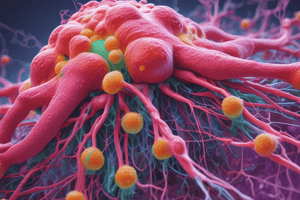Podcast
Questions and Answers
What role do mucosal surfaces play in immune defense?
What role do mucosal surfaces play in immune defense?
- They help in the maturation of T cells.
- They serve as a barrier against external infections. (correct)
- They produce red blood cells for oxygen transport.
- They promote the growth of pathogens.
What initiates the inflammatory response in the body?
What initiates the inflammatory response in the body?
- The activation of pattern recognition receptors. (correct)
- The presence of red blood cells.
- The formation of new lymphatic vessels.
- The gradual deterioration of external epithelia.
Which of the following best describes the function of lymph nodes?
Which of the following best describes the function of lymph nodes?
- They transport oxygen throughout the body.
- They transport carbon dioxide out of the bloodstream.
- They filter and store nutrients for immune responses.
- They serve as hubs for immune cell interaction and activation. (correct)
What is the primary function of the thymus in the immune system?
What is the primary function of the thymus in the immune system?
Which of the following is NOT a classic sign of inflammation?
Which of the following is NOT a classic sign of inflammation?
What is the main function of neutrophils in the innate immune response?
What is the main function of neutrophils in the innate immune response?
Which type of immune response is characterized by limited specificity and quick action following an infection?
Which type of immune response is characterized by limited specificity and quick action following an infection?
What distinguishes dendritic cells from other phagocytic cells in the immune system?
What distinguishes dendritic cells from other phagocytic cells in the immune system?
What role does the complement system play in the immune response?
What role does the complement system play in the immune response?
How do innate and adaptive immune responses differ in terms of memory?
How do innate and adaptive immune responses differ in terms of memory?
What is the primary role of macrophages in the immune system?
What is the primary role of macrophages in the immune system?
What triggers the adaptive immune response?
What triggers the adaptive immune response?
Which characteristic is NOT associated with adaptive immune responses?
Which characteristic is NOT associated with adaptive immune responses?
Which class of antibodies is the most abundant in serum?
Which class of antibodies is the most abundant in serum?
Which type of T cell recognizes antigens presented on MHC class I molecules?
Which type of T cell recognizes antigens presented on MHC class I molecules?
What distinguishes B cell receptors from T cell receptors?
What distinguishes B cell receptors from T cell receptors?
Which of the following roles do CD4 T cells perform?
Which of the following roles do CD4 T cells perform?
What is the primary location for the activation of adaptive immune cells?
What is the primary location for the activation of adaptive immune cells?
What is a key feature of immunological memory in the adaptive immune system?
What is a key feature of immunological memory in the adaptive immune system?
What distinguishes IgE antibodies from other classes?
What distinguishes IgE antibodies from other classes?
Which of the following statements about T cell differentiation is true?
Which of the following statements about T cell differentiation is true?
Which statement accurately describes the difference between innate and adaptive immune responses?
Which statement accurately describes the difference between innate and adaptive immune responses?
The spike protein is an example of what?
The spike protein is an example of what?
Flashcards are hidden until you start studying
Study Notes
Immune Defences
- External Epithelia: Skin, mucous membranes (airways, gastrointestinal tract, reproductive tract) provide the first line of defense.
- Secretions: Mucus, cilia, defensins act as additional barriers.
- Inflammation: Occurs when barriers are breached; involves activation of pattern recognition receptors, triggering release of signaling molecules like histamine, peptides, cytokines, and chemokines.
- Signs of Inflammation: Pain, heat, redness, swelling.
Lymphatic System
- Lymphatic Vessels: Transport lymph throughout the body.
- Lymph Nodes: Intersections of lymphatic vessels, acting as immune cell hubs for interaction and activation.
- Lymph: Colorless fluid containing white blood cells that circulates within the lymphatic system.
- Thymus: Organ responsible for T cell development and maturation.
- Spleen: Filters blood, removes damaged red blood cells, and stores white blood cells.
Immune Cells
- Blood: Contains red blood cells (oxygen transport) and white blood cells (immune defense).
Red Blood Cells
- Carry oxygen.
- 5-6 million per microliter of blood.
- Production rate: ~2 million per second.
- Lifespan: ~110 days.
- Transport oxygen and carbon dioxide.
White Blood Cells
- Immune cells, numerous types including: neutrophils, macrophages, monocytes, eosinophils, mast cells, basophils, T cells, B cells, and dendritic cells.
- Classified as innate or adaptive immunity.
Innate Immunity
- Initial response (within 12 hours) to danger signals and activation of immune cells.
- Limited specificity.
- Found in all tissues, especially at barrier sites.
- Rapid response following infection.
- Limited memory.
Adaptive Immunity
- Takes longer to activate (days following barrier breach).
- Highly specific to particular proteins/antigens.
- Primarily found in lymphoid organs.
- Long-lasting memory.
Key Players In Innate Immunity:
- Neutrophils: Most abundant white blood cell, active phagocytic cells, engulf and kill pathogens, employ neutrophil extracellular traps (NETs) to trap and kill pathogens, short-lived.
- Macrophages: Develop from precursors in tissues, active phagocytic cells, consume and kill pathogens, activated by inflammation, long-lived.
- Dendritic Cells: Develop from precursors in tissues, active phagocytic cells, migrate from peripheral tissues to lymph nodes, transport antigens to T cells in lymph nodes, bridge innate and adaptive immunity by activating the adaptive immune response.
- Complement: Cascade of proteins in serum (blood) that sense danger, enhances immune response, activated by antibodies or pathogen molecules, can directly kill pathogens or attract immune cells to an infection site.
Stages of Adaptive Immune Response:
- Triggered by innate immune response.
- Dendritic cells, macrophages, and neutrophils signal to adaptive immune cells.
- Innate immune cells can clear mild infections; otherwise, they alert adaptive immune cells.
- T Cell Activation: Finding the right T and B cells.
- T Cell Differentiation: Deciding how to respond.
- T Cell Effector Stage: Immune response.
B Cells
- B cell receptors (BCRs) can bind to native proteins or antigens without accessory cells (processing not required).
- Up to 10^12 different BCRs.
- Produce antibodies, classified into different types:
- IgM: Low affinity, high avidity.
- IgG: Most abundant antibody in serum.
- IgA: Found at mucosal sites.
- IgE: Involved in allergy and anti-helminth worm responses.
- Antibodies are made by plasma cells (differentiated B cells).
- Antibody mechanisms:
- Neutralize pathogens.
- Activate complement to enhance immune response.
- Enhance phagocytosis (opsonization) by binding to receptors on phagocytes.
T Cells
- Around 10^8 different T cell receptors (TCRs).
- T cells recognize processed antigens presented on MHC molecules on the surface of antigen-presenting cells (require accessory cells).
- CD4 T cells (Helper T cells):
- Recognize longer peptides on MHC class II molecules, expressed by professional antigen-presenting cells (B cells, macrophages, dendritic cells).
- Support other immune cells by:
- Enhancing CD8 T cell responses.
- Aiding B cells in producing high-affinity antibodies.
- Activating macrophages for more effective pathogen destruction.
- CD8 T cells (Cytotoxic T cells):
- Recognize shorter peptides on MHC class I molecules, expressed by all nucleated cells (B cells, macrophages, dendritic cells, epithelial cells).
- Kill infected cells and tumor cells by releasing toxic granules.
- Memory trick: 4 x 2 = 8 (CD4 T cells with MHC class II), 8 x 1 = 8 (CD8 T cells with MHC class I).
Specificity:
- Spike Protein: Antigen found on the surface of some viruses.
- Epitope: Peptide chains, parts of an antigen recognized by immune receptors (BCRs and TCRs).
Adaptive Immune Cell Locations:
- Generation: Primary lymphoid organs (thymus and bone marrow).
- Activation: Secondary lymphoid organs (lymph nodes and spleen).
Timings of the Immune Response:
- Innate: 0-5 days (dendritic cells, neutrophils, macrophages, monocytes).
- Adaptive: 3-15 days (B cells, CD4 T cells, CD8 T cells).
- Long-lived: Months to years (long-lived plasma cells, memory B and T cells).
Immunological Memory
- Enables rapid control of previously encountered pathogens.
- Memory T and B cells provide a rapid response upon reinfection.
- Memory cells act at different locations in the body to protect the host.
Key Points
- B and T cells form the adaptive immune system.
- Specialized receptors (BCRs and TCRs) on their surfaces allow recognition of antigens.
- B cells produce pathogen-specific antibodies.
- CD4 T cells coordinate other immune cells.
- CD8 T cells kill infected cells and tumors.
- Memory T and B cells ensure rapid responses to previously encountered pathogens.
Studying That Suits You
Use AI to generate personalized quizzes and flashcards to suit your learning preferences.




